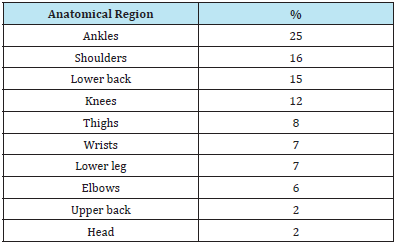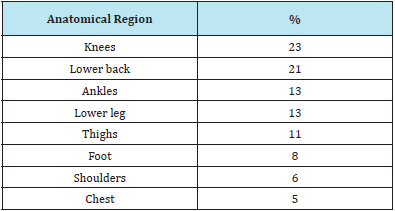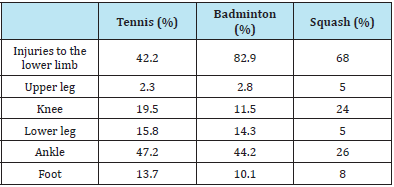- Submissions

Full Text
Orthoplastic Surgery & Orthopedic Care International Journal
Common Injuries in Racket Sports: A Mini Review
Ibrahim Hamed Ibrahim Hassan1* and Mohammed A. Elgammal2
1Department of Theories and Applications of Racket Sports, Faculty of Physical Education, Zagazig University, Egypt
2Department of Theories and Applications of Team Sports, Faculty of Physical Education, Zagazig University, Egypt
*Corresponding author: Ibrahim Hamed Ibrahim Hassan, Department of Theories and Applications of Racket Sports, Faculty of Physical Education, Zagazig University, 44519, Zagazig, Egypt
Submission: January 29, 2018;Published: March 20, 2018

ISSN: 2578-0069Volume1 Issue4
Abstract
The most injuries of racket sports players involve a critical association between the movement tasks and training programs strategies. This mini review highlights on the common injuries and anatomical regions of tennis, badminton and squash players injuries. The large majority of injuries, when recognized early on, can be prevented effectively with minor adjustments in the training programs, rehabilitation of essential muscles and flexibility imbalances, and awareness to proper footwear. According to the review data of previous studies, the majority of common injuries in racket sports related to the lower limb and observed with higher rate in badminton when compared to tennis and squash sports.
Background
Tennis, badminton, and squash considered as racket sports, even tennis sport are the most popular all over the world. Before discussing the possibilities mechanisms that limit the injuries for players of these sports, we must describe the characteristics of these sports imposed on the players. Hughes & Bartlett [1] describe racket sports as net and wall games that are score dependent rather than time dependent. The player racket sports will have unique indicators as a result of different rules relating to the number of serves permitted the number of bounces permitted and volleying. However, common factors relating to all net and wall games are identified as serves, shots, winner and rallies length [1].
The development of sports science and the commercialization of racket sports in recent years have focused attention on improved performance and this has led to a more detailed study and understanding of all aspects of racket sports. In addition, these sports are vary with each other in many extents such as the scientific disciplines of sports physiology, nutrition, performance analysis, biomechanics, medicine, engineering, psychology, motor skills and injuries [2]. The patterns of injury reflect the changes in training, more aggressive styles of play, grip modifications and open stance forehands, as well as improved physical abilities of the players [3].
Studies from Scandinavia reported that sports injuries constitute 10-19% of all severe injuries treated in the emergency room and the most common injury types are knee and ankle injuries [4]. In context of common injuries in racket sports, previous studies have shown that the player exposed to injury at (knee, foot, wrist, shoulder and lumbar back) in tennis [5], (lumbar back, shoulder, wrist, ankle and foot) in badminton [3] and (knee, lumbar back and ankle) in squash [3]. On the other hand, the common injuries of upper body region such as head and neck injuries in racket sports are unique; however elbow and shoulder as common injuries are relatively related to these sports.
There are some similarities of injuries in racket sports such as knee and ankle injuries, but there are some principles must be taken into considerations when comparing injury data from the racket sports such as differences in injury definition, study design methods of data collection, population under study and observation period which may lead to substantial variations [6]. Therefore, injury prevention strategies are of great importance for teams at both recreational and professional levels. Establishing the extent of the injury problem is considered the first step towards effective prevention [7].
What Types of Injuries are most common in Racket Sports?
Racket sports have many possibilities for incidence and overuse injuries. In tennis sport, two-thirds of injuries are due to overuse and the one-third is due to a traumatic injury or acute event. Overuse injuries most often affect the elbows, wrists, and shoulders [8]. In squash, the majority squash injuries occur to the lower limb 32% to 58% of all injuries, and the authors also stated in their review that ankle was found to be the most frequent injury site contributing to 13% to 16% of all squash injuries and followed by the knee accounted for 7%to 9% [9]. In badminton, Goh et al. [10] reported that the one-third of injuries occurred on the lower limb especially in region knee and back injuries. The following tables summarize the percentage distribution of reported injuries for tennis, badminton, and squash sports in previous studies.
The descriptive data in Table 1 reported by previous studies of [5,11-14]. Tennis injuries may occur in many musculoskeletal areas but will most likely be in the ankles, lower back and shoulders. Ankle sprains are the most common injury in tennis as well as in many sports. On the other hand, tendinitis was mostly found in the elbow or shoulders, presumably due to repeated stress, which gives credence to the previous speculation that most injuries will be caused by chronic overuse. These findings were also previously observed by numerous studies [8,15-17].
Table 1: Percentage distribution of injuries by anatomical region in tennis sport.

Injuries percentage distribution by anatomical region for badminton players in Table 2 reported by Goh et al. [10], who suggested that Badminton injuries may occur in many musculoskeletal areas but will most likely be in the knees, lower back and ankles/lower leg. Knees sprains/strains are the most common injury in badminton. On the other hand, tendinitis was mostly found in the knees or ankles, presumably due to repeated stress, which gives credence to the previous speculation that most injuries will be caused by chronic overuse.
Table 2: Percentage distribution of injuries by anatomical region in badminton sport.

Injuries percentage distribution by anatomical region for squash players in Table 3 reported by [18], who suggested that injuries in squash may occur in many musculoskeletal areas but will most likely be in the knees, neck, and shoulders. Knees sprains/strains are the most common injury in squash. From the above-demonstrated data of the distribution by anatomical region in racket sports, it could be concluded that most popular common injuries in this sports are related relatively to the lower limb. In this regard, Krell et al. [19] documented as presented in the Table 4 the distribution of racket sports injuries which occurred at the lower limb
Table 3: Percentage distribution of injuries by anatomical region in Squash sport.

Table 4: Distribution of racket sport injuries to the lower limb, reported by Krell et al. [19] from previous studies.

The presented data in Table 4 demonstrates that injuries which related to the lower limb in racket sports found with high rates in badminton with (82.9%), followed by squash (68%) and tennis (42.2). In addition, the data confirmed that all injuries in racket sports affected the lower extremity with the ankle as the most affected site in tennis, badminton, and squash (47.2%, 44.2% and 26%), respectively.
What are the Incidences of Common Injuries in Racket Sports?
In tennis sport, the injury incidence varied from 0.05 to 2.9 injuries per player per year. Per hour of play, the reported incidence varied from 0.04 injuries per 1000 hours to 3.0 injuries per 1000 hours. Incidence and prevalence rates for tennis elbow were quite high, with reported incidence varying from 9% to 35% and prevalence varying from 14% to 41% [5,20,21].
In badminton sport, injuries have been reported to occur at a rate of 2.9 injuries per player per 1000 hours of badminton playing. Injuries that related to this sport tend to be due to overuse as badminton is a non-contact sport. Badminton players requires explosive power for flicks of the wrist, jumps, lunges and rapid changes of direction and these repeated movements actions can put stress on the tissues and cause injury [10,22].
The rate of injuries in squash sport is 18 injuries per 1000 hours of participations. In addition, Eime et al. [23] reported that 194 Australian participants admitted to the hospitals for squash related injuries, with a rate of 58 injuries per 100,000 squash and racket ball players [23].
How are Racket Sports Injuries Treated?
When the injury occurred, the player should stop any activity such as training or competition until he examined by hospitals or sports medicine center or any professional person. These procedures are often taken when major occur. In any minor injuries occurred, the treatment usually includes rest, ice, and elevation.
The American Orthopedic Society for Sports Medicine recommends that some of the injuries require additional investigations with X-rays or MRI and mostly need a longer time of rest followed by rehabilitation program and a gradual return to play as symptoms permit. Also, the players should return to the main sport activity after appropriate physician investigation, and only when completely symptoms free [15].
How can Racket Sports Injuries be Prevented?
There are different injuries that most commonly occur in racket sports. So below there are some important tips for preventing racket sports injuries which includes:
a. The prevention procedures are needed to reduce the frequency and severity of racket sports.
b. Balance training with eyes opened and closed is a useful.
c. Core stability training will be beneficial for tennis and badminton players.
d. Coordination and agility exercises should be incorporated in daily training sessions to help minimize the rate of injuries.
e. The injuries in racket sports will be preventable when endurance and strength training performed prior to extensive playing activities.
f. Footwear is critical for all players in racket sports to preventing stress fractures.
g. Organized warm-up followed by stretching can help diminish muscle strains.
h. Warm-up should include sprints between 10 to 20 meters at medium intensities.
i. The hold time of stretching exercises 30 seconds or more.
j. The wearing of eye protection such as prescription glasses is important for squash player.
k. The taping and bracing protect racket sports players with joint injuries.
l. A lighter racket is less likely to cause injury and especially for beginners when their wrist and forearm muscles are not enough strong.
References
- Hughes MD, Bartlett RM (2002) The use of performance indicators in performance analysis. J Sports Sci 20(10): 739-754.
- Lees A (2003) Science and the major racket sports: a review. J Sports Sci 21(9): 707-732.
- Jayanthi N, Esser S (2013) Racket sports. Current sports medicine reports. Curr Sports Med Rep 12(5): 329-336.
- Bahr R, Kannus P, Van Mechelen W, Kjær M, Krogsgaard M, et al. (2003) Epidemiology and prevention of sports injuries. Textbook of Sports Medicine: Basic Science and Clinical Aspects of Sports Injury and Physical Activity, pp. 299-314.
- Mc Curdie I, Smith S, Bell PH, Batt ME (2017) Tennis injury data from the championships, Wimbledon, from 2003 to 2012. Br J Sports Med 51(7): 607-611.
- Pluim B (2004) Physiological demands and injury in racket sports: differences and similarities. In: Science and racket sports III: The proceedings of the eighth international table tennis federation sports science congress and the third world congress of science and racket sports, Volume 69.
- Van Mechelen W, Hlobil H, Kemper HC (1992) Incidence, severity, aetiology and prevention of sports injuries. A review of concepts. Sports Med 14(2): 82-99.
- Pluim BM, Staal JB, Windler GE, Jayanthi N (2006) Tennis injuries: occurrence, aetiology, and prevention. Br J Sports Med 40(5): 415-423.
- Finch CF, Eime RM (2001) The epidemiology of squash injuries. International Sport Med Journal 2(2): 1-11.
- Goh SL, Mokhtar AH, Mohamad Ali MR (2013) Badminton injuries in youth competitive players. J Sports Med Phys Fitness 53 (1): 65-70.
- Kühne C, Zettl RP, Nast Kolb D (2004) Injuries and frequency of complaints in competitive tennis and leisure sports. Sportverletzung Sportschaden 18(2): 85-89.
- Pluim B, Loeffen F, Clarsen B, Bahr R, Verhagen E (2016) A one season prospective study of injuries and illness in elite junior tennis. Scand J Med Sci Sports 26(5): 564-571.
- Sallis R, Jones K, Sunshine S, Smith G, Simon L (2001) Comparing sports injuries in men and women. Int J Sports Med 22(06): 420-423.
- Valleser CWM, Narvasa KEL (2017) Common injuries of collegiate tennis players. Monten J Sports Sci Med 6 (2): 43-47.
- Hootman JM, Dick R, Agel J (2007) Epidemiology of collegiate injuries for 15 sports: summary and recommendations for injury prevention initiatives. J Athl Train 42(2): 311-319.
- Kibler WB, Safran M (2005) Tennis injuries. In: Caine DJ, Maffulli N (Eds.), Epidemiology of pediatric sports injuries- Volume 48. Karger Publishers, Switzerland, pp. 120-137.
- Rechel JA, Yard EE, Comstock RD (2008) An epidemiologic comparison of high school sports injuries sustained in practice and competition. Journal of Athletic Training 43(2): 197-204.
- Sankaravel M, Lee A, Mondam S, Low J (2017) Prevalence of musculoskeletal injuries among young squash players in malaysia. Journal of Fundamental and Applied Sciences 9(6S): 1132-1140.
- Krell ES, Montemurro NJ, Pacific KP, Emele L, Lin SS (2017) Orthobiologics in foot & ankle. In: Valderrabano V, Easley M (Eds.), Foot and Ankle Sports Orthopaedics. Springer, USA, pp. 119-125.
- Jayanthi N (2005) Skill level related injuries in recreational competitive tennis players. Medicine & Science in Tennis 10(1): 12-15.
- Van Mechelen J, Nauta J, Pluim B, Verhagen E (2017) Risk factors for injuries in elite youth tennis players. British Journal of Sports Medicine 51(4): 402-403.
- Yung PS, Chan RH, Wong FC, Cheuk PW, Fong DT (2007) Epidemiology of injuries in Hong Kong elite badminton athletes. Res Sports Med 15(2): 133-146.
- Eime R, Zazryn T, Finch C (2003) Epidemiology of squash injuries requiring hospital treatment. Inj Control Saf Promot 10(4): 243-245.
© 2018 Ibrahim Hamed Ibrahim Hassan. This is an open access article distributed under the terms of the Creative Commons Attribution License , which permits unrestricted use, distribution, and build upon your work non-commercially.
 a Creative Commons Attribution 4.0 International License. Based on a work at www.crimsonpublishers.com.
Best viewed in
a Creative Commons Attribution 4.0 International License. Based on a work at www.crimsonpublishers.com.
Best viewed in 







.jpg)






























 Editorial Board Registrations
Editorial Board Registrations Submit your Article
Submit your Article Refer a Friend
Refer a Friend Advertise With Us
Advertise With Us
.jpg)






.jpg)














.bmp)
.jpg)
.png)
.jpg)










.jpg)






.png)

.png)



.png)






